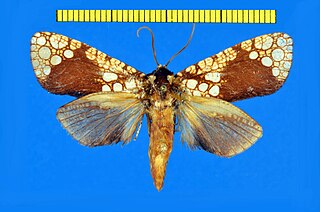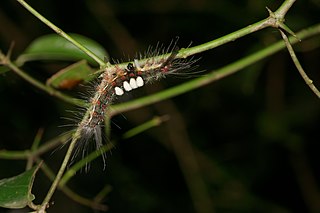
Moths are a paraphyletic group of insects that includes all members of the order Lepidoptera that are not butterflies, with moths making up the vast majority of the order. There are thought to be approximately 160,000 species of moth, many of which have yet to be described. Most species of moth are nocturnal, but there are also crepuscular and diurnal species.

The Sphingidae are a family of moths (Lepidoptera), commonly known as hawk moths, sphinx moths, and hornworms; it includes about 1,450 species. It is best represented in the tropics, but species are found in every region. They are moderate to large in size and are distinguished among moths for their agile and sustained flying ability, similar enough to that of hummingbirds as to be reliably mistaken for them. Their narrow wings and streamlined abdomens are adaptations for rapid flight. The family was named by French zoologist Pierre André Latreille in 1802.

The Tachinidae are a large and variable family of true flies within the insect order Diptera, with more than 8,200 known species and many more to be discovered. Over 1300 species have been described in North America alone. Insects in this family commonly are called tachinid flies or simply tachinids. As far as is known, they all are protelean parasitoids, or occasionally parasites, of arthropods, usually other insects. The family is known from many habitats in all zoogeographical regions and is especially diverse in South America.

The Tortricidae are a family of moths, commonly known as tortrix moths or leafroller moths, in the order Lepidoptera. This large family has over 10,350 species described, and is the sole member of the superfamily Tortricoidea, although the genus Heliocosma is sometimes placed within this superfamily. Many of these are economically important pests. Olethreutidae is a junior synonym. The typical resting posture is with the wings folded back, producing a rather rounded profile.

Dudgeonea is a small genus of moths and the only genus of its family, the Dudgeoneidae. It includes six species distributed sparsely across the Old World from Africa and Madagascar to Australia and New Guinea.

The name death's-head hawkmoth refers to any of three moth species of the genus Acherontia. The former species is found in Europe and throughout Africa, the latter two are Asian; most uses of the common name refer to the European species. These moths are easily distinguishable by the vaguely human skull-shaped pattern of markings on the thorax. They are large nocturnal moths with brown and yellow or orange coloring, and all three species are fairly similar in size, coloration and life cycle.

Colophospermum mopane, commonly called mopane, mopani, balsam tree, butterfly tree, or turpentine tree, is a tree in the legume family (Fabaceae), that grows in hot, dry, low-lying areas, 200 to 1,150 metres in elevation, in the far northern parts of southern Africa. The tree only occurs in Africa and is the only species in genus Colophospermum. Its distinctive butterfly-shaped (bifoliate) leaf and thin seed pod make it easy to identify. In terms of human use it is, together with camel thorn and leadwood, one of the three regionally important firewood trees.

The Hepialidae are a family of insects in the lepidopteran order. Moths of this family are often referred to as swift moths or ghost moths.

The Lymantriinae are a subfamily of moths of the family Erebidae. The taxon was erected by George Hampson in 1893.

The Coleophoridae are a family of small moths, belonging to the huge superfamily Gelechioidea. Collectively known as case-bearers, casebearing moths or case moths, this family is represented on all continents, but the majority are found in temperate areas of the Northern Hemisphere. They are most common in the Palearctic, and rare in sub-Saharan Africa, South America, and Australia; consequently, they probably originated in northern Eurasia. They are relatively common in houses, they seek out moist areas to rest and procreate.

Nepticulidae is a family of very small moths with a worldwide distribution. They are characterised by eyecaps over the eyes. These pigmy moths or midget moths, as they are commonly known, include the smallest of all living moths, with a wingspan that can be as little as 3 mm in the case of the European pigmy sorrel moth, but more usually 3.5–10 mm. The wings of adult moths are narrow and lanceolate, sometimes with metallic markings, and with the venation very simplified compared to most other moths.

Acherontia atropos, the (African) death's-head hawkmoth, is the most widely recognized of three species within the genus Acherontia. It is most commonly identified by the vaguely skull-shaped pattern adorning the thorax, the characteristic from which its common and scientific names are derived. The species was first given its scientific name by Carl Linnaeus in his 1758 10th edition of Systema Naturae.

The Somabrachyidae are a family of moths in the order Lepidoptera.
Prototheora is a genus of moths. It is the only genus of the Prototheoridae, or the African primitive ghost moths, a family of insects in the lepidopteran order, contained in the superfamily Hepialoidea. These moths are endemic to Southern Africa.

Hippotion celerio, the vine hawk-moth or silver-striped hawk-moth, is a moth of the family Sphingidae. It was described by Carl Linnaeus in his 1758 10th edition of Systema Naturae.
Robert Herbert Carcasson was an English entomologist who specialised in butterflies, but also authored two field guides to tropical fishes. He joined the Coryndon Museum, Nairobi, as senior entomologist in 1956. He then became its director, under the museum's new name of the Natural History Museum from 1961 to 1968. During this time he was awarded a PhD for his studies on African hawkmoths. From 1969 to 1971 he was Chief Curator of the Centennial Museum, Vancouver, Canada. In 1972 he travelled in Polynesia, Melanesia, Australia, Malaysia, Sri Lanka, Seychelles and East Africa for production of two field guides to coral reef fish of the Indo-Pacific region. From 1973 to 1979 he was Curator of Entomology at the Museum of British Columbia. He died of cancer. Somewhat a polymath, he was fluent in a number of languages, and produced the illustrations to a number of his works, culminating in hundreds of colour and line drawings of fishes for his reef fish field guides.

Palpita vitrealis, common name jasmine moth or white pearl, is a species of moth of the family Crambidae.
Louis Beethoven Prout (1864–1943) was an English entomologist and musicologist.
The Metarbelidae are a family of the Cossoidea also called the carpenter or goat moths, and is sometimes treated as a subfamily, Metarbelinae of the Cossidae. No synapomorphies are shared with the Cossidae based on adult morphology. The family Metarbelidae was first described by Embrik Strand in 1909.
Dr Anthonie Johannes Theodorus Janse, also known as Antonius Johannes Theodorus Janse and by other orthographic variations, was a pioneer of South African entomology who specialised in Lepidoptera. His multi-volumed work, The Moths of South Africa is recognized as a definitive text.















